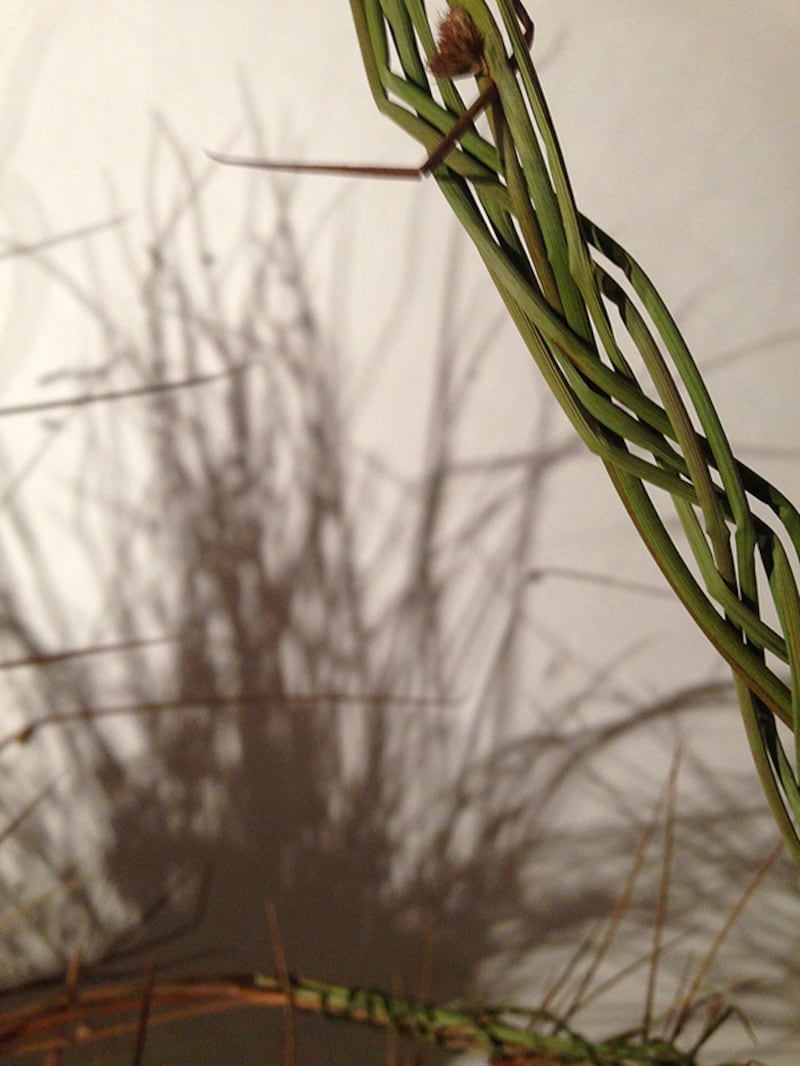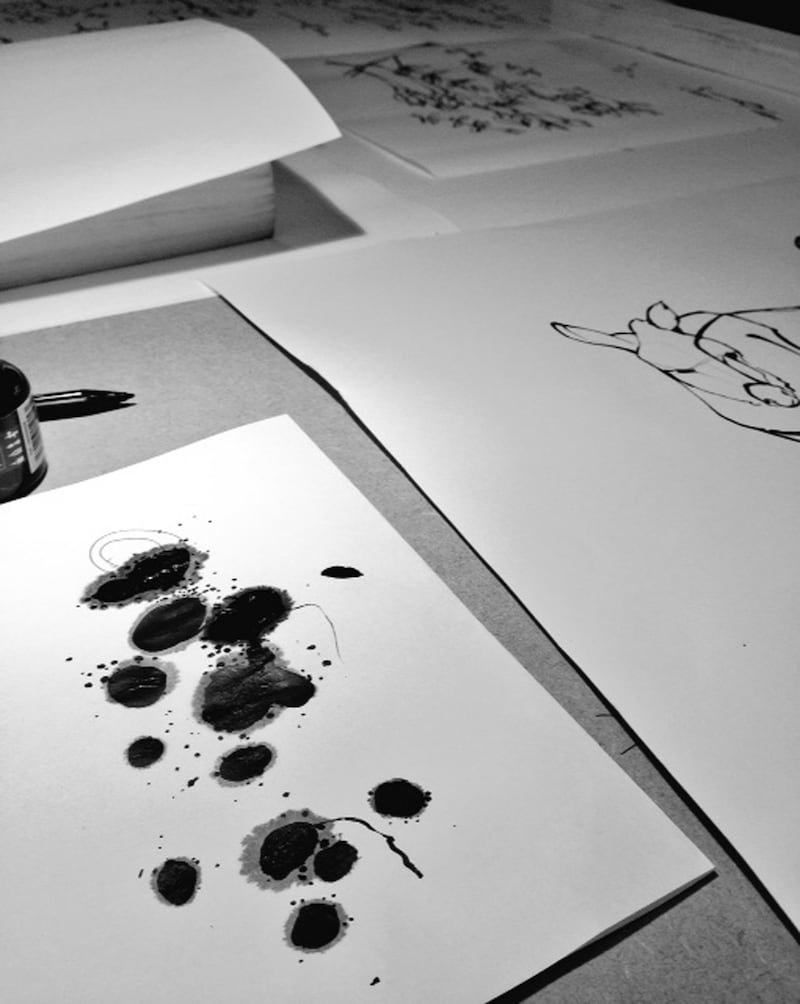“When counterfeit realities are all around us,” Zadie Smith says, “the desire to see things as they are is itself a radical act.” By seeing things, she doesn’t mean some clear, linear narrative but instead an apprehension of the world in all its complexity.
Seizing and relating the intricacy and depth of our experiences, of the world around us, is what creative people have always hunted. Since humans first painted on cave walls, since someone first carved “I was here”, we have been trying to show, to tell.
We have an image of the lonely artist with this purpose, Smith says, but things might be changing – to a future that is more interconnected and collaborative.
Poet Liz Quirke and visual artist Yvonne Hennessy are all about this interconnection and responsiveness. The Road, Slowly (Salmon 2018), is Quirke's debut poetry collection which illuminates and investigates her experience of non-biological motherhood. Hennessy's work responds visually to Quirke's poems through inks, drawings and installations, voicing her own experience of birth and becoming a mother. How do they approach these related experiences through their distinct practices? What are their ways of seeing?
“Everything starts with observation,” says Hennessy. “I’ll stand looking at something for hours; if I’m drawing an animal, I might observe them for days, rain or shine. Depending on where I’m working, I’ll take up the whole space and observe the work from different vantage points. I will analyse an animal anatomically, working from the inside out. Only after this do I start to make the work in the studio.”

Hennessy’s work is born from the beauty of Connemara where she lives with Quirke and their two daughters; for her the natural world is where everything begins and ends. “It’s my inspiration and my medium; instead of using paint brushes, I’ll use branches, twigs, rushes and berries. If I’m creating an installation, I’ll use peat, rushes and briars.”
Although she is not a poet of the natural world in the same sense that Eleanor Hooker or Breda Wall Ryan are, in whose work animals and birds turn mythic and metaphorical, Quirke says that an apprehension of scene is vital to her poetry.
“My poems stem from an image. When I’m editing, I always question what way the scene looks: have I left anything out? What’s the hierarchy within the composition? That language and way of looking is something I’ve learned from Yvonne’s practice.”
To realise a poem, time is essential for Quirke, something she needs to distil and document moments and ideas. “With the girls or with Yvonne, an event or an exchange might happen and I know somehow that this will become a poem. It takes me a while to feel something and articulate it. All that time, though, it will have been stewing somewhere in my subconscious until something sparks and blazes and I start writing. I’ll live in work for a long time, so a poem can be a work in progress for years.”
In poems such as When is the rainbow, momma; Ashes; and Juno, Quirke writes those "obstinate details" that Eavan Boland references in Object Lessons – the ordinariness of steadfast love, the God in small things. She is part of the bright future that Anne Enright talks of, comfortable writing about anything, including the body, the domestic.
“I think women artists can decide for themselves if they are happy to put their work out into the world regardless of reception or judgement; Anne Enright puts it best when she says that men and women are held to a different standard. I know that some people will avoid my work. Some will judge it solely on its themes or the fact that I’m a gay woman writing about motherhood. But sincerely – life is way too short to worry about what other people think.”
In a recent piece about her time as Laureate of Irish Fiction, Enright says that making arguments about gender "will eat your head, your talent and your life". Fortunately for Quirke a large part of her PhD at NUIG, The Fuchsias Bending Low: A Study Of Irish Women Poets in Contemporary Irish Poetry Publishing, will involve her own practice, whilst balancing an investigation of the influence of gender in the area.

The fuchsias in the title of Quirke's doctorate owe life to Nuala Ní Dhomhnaill's lavish Leaba Shioda. All of us have scents, sensations, objects that are significant from our early years. As Louise Glück puts it, "we look at the world once, in childhood. The rest is memory." For Quirke, fuchsia is special.
“Liz has a thing for fuchsia,” says Hennessy, for whom ordinary life is also a reservoir. “One day we were outside sitting on the windowsill having a cup of tea, watching the girls. We ended up talking about the fuchsia in the ditch and Liz told me when she was small she used to make earrings out of the flowers. A few weeks later I was outside with the girls, and Juno came up to me; she had some in her hands and tried to put them on my ears. 'Look, Mammy,' she said, 'earrings!' This inspired a whole series of fuchsia inks.”
These moments of revelation are what artists have always chased. But sometimes the divergence between idea and execution can be frustrating. "When I wrote The Glass Essay," says Anne Carson, in the Art of Poetry 88, "I wanted to do something that I would call understanding what life feels like, and I don't believe I did. I also don't know what it would be to do that, but if you read Virginia Woolf or George Eliot, there's a fragrance of understanding you come away with – this smell in your head of having gone through something that you understood with the people in the story."
Neither Quirke nor Hennessy see failure or success in terms of outside approval, despite both winning awards and the respect of their peers; they believe the process and integrity of the work to be its own litmus. For Hennessy, some of her best work has come from “failure”. “Take the fuchsia inks. They came out of failing. I was trying to do something else, and I didn’t succeed. So I went outside and my aim was to look at the ditch, let the ink fall and not try to represent anything but let the ‘seeing’ become the work. The ink was falling and if the wind had blown from a different direction, things would have turned out differently.”
Describing The Road, Slowly, Hooker says that Quirke "chronicles the miracle, challenges and traumas of motherhood and of being." Despite the connection between the artists, Quirke emphasises that she can write about these experiences purely from her perspective.
“I never attempt to speak for Yvonne or the girls. I just observe as best I can and write. There isn’t one way to be a mother and that multiplicity of perspective is valid. I really wanted to find work that spoke to a non-biological lesbian motherhood in this time. I wanted to know if what I was feeling was acceptable, that the fears I had were valid and I had to write that work for myself. I feel like I wrote myself into being a mother.”
Nurture
In the nine months I didn't nourish you,
I made notes, I studied the seasons
for ingredients to encourage your growth.
Scraps of paper, post-its hidden
in case anyone would view my thoughts,
pity my trivia of leaves and berries.
A mom yet not a mother,
a woman yet not a woman.
My preparation took place in private,
not in maternity wards or hospital corridors,
but in the hallways of my mind
where I could put up pictures, time lines,
fill cork boards with plans.
As the folic acid built your brain stem
I collated ideas to stimulate it further,
mapped journeys for us,
paths we could walk together,
a staggered relay to start
when your other mother
passed your tiny form to me.
And I could see myself holding your hand,
using my limbs to scaffold the structure
your mother put so beautifully in place.
I am your mom without the biology of mothering.
All I have for you is my heart, my brain, my lists of things,
all but those nine months when I was waiting.
For Hennessy, the poems in this collection are an articulation of her own experience as much as Quirke’s. “Liz’s book is focused on us becoming a family and having our daughters and we’ve lived it all together. It was never going to be as simple as taking her poems and illustrating them. I had to go into the work and find my own version of it.”
An example of this is The Weight of Chaos, which is a two-dimensional hand-drawn animation projected onto a three-dimensional object; it is a visual response to Quirke's poem Nurture. "I had to locate myself in that experience. For her it is the words on the page, for me it is the contrasting images. I lived the hospitals and carried our daughters in my body, so articulating that and presenting that work together was really intense. It's probably that part of our life condensed in a nutshell."
Quirke and Hennessy reveal how they see things in distinct and separate voices – yet also connect the arpeggios of their experiences through each other’s work. Those first drawings of humans on cave walls were of shamans, visionaries. We have different words for that state of consciousness we enter in order to “see”: concentration, flow, trance – whether it’s a girl drawing a flower, the deep work of a gifted translator, or the rapture of a musician. They are all ways of seeing. Quirke and Hennessy’s work shows that an interesting future lies not only in the age-old attempt to express our unique place in the world, but also in engaging with how others perceive the intimate experiences that bind us.
“I am interested when something latent becomes known,” says Enright. “When you are really working it, every sentence in a story does many things, all at once. They are like three-dimensional crosswords. Or am I describing a flower?”
- Ruth McKee is editor of online arts magazine Spontaneity, was shortlisted for the Hennessy New Writer of the Year 2017 and was joint winner of The Irish Novel Fair 2015









